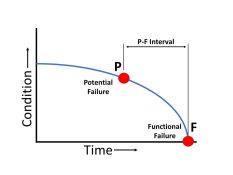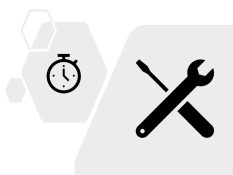Layman Explanation of MTTR (Mean Time To Repair or Replace)
The term Mean Time To Repair (or Replace) is used in maintenance management for expressing important information related time required for repairing a faulty piece of equipment.
In today’s article, we will explain MTTR in such a simple way that even a layman would understand it by the end of this article.
Appreciating the Complexity of MTTR
Mean Time To Replace or Repair (MTTR) is the average time taken to restore a machine or piece of equipment to its normal operational state after it has become unavailable for operation due to a fault or failure.
In cases where replacement is carried out instead of repair (imagine replacing the axle of an automobile because it can’t be fixed), the “R” in the end of “MTTR” represents Replace instead of “Repair”.
For example, if in a course of a month, a heavy-duty pump broke down three times. The first time it took 20 minutes to restore it back to service. The second time it took 45 minutes and the third time it took 120 minutes to restore the pump, the Mean Time To Repair (MTTR) for the pump would be the average of 20, 45 and 120 i.e., 48 minutes.
While it may sound simple, the devil is in the details.
When we said it took 20 minutes to repair the pump and restore it back to the service, does 20 minute include the time it took for the technician to reach site?
Does it represent the time it took to diagnose the fault or just the time for the repair? For instance, if a seal had ruptured, does 20 minute include the time it took to find the ruptured seal by the technician? Or is it just the time of removing the old seal and replacing it with new one?
Does it include the time it took for a helper to get a new seal issued from the store?
Does it include the time it took to test the pump after the repair had been performed?
To know what exactly is reflected by the metric Mean Time to Repair/Replace (MTTR), it is necessary that you know the answer to above questions. Only after that will you be able to understand why this metric even exists? What benefit does it provide?
Understanding Time To Repair (TTR) – The Key to Understanding MTTR
Let us define what is termed as Time To Repair (TTR) in maintenance management. Once you understand what is Time to Repair (TTR), understanding Mean Time To Repair (MTTR) will become a no brainer (because it is just the mean or average value of TTR).
So, what is the Time To Repair (TTR) in a maintenance organization?
The timer starts from the moment maintenance department has been informed of an equipment going out of service. If the operations made the call to maintenance at 12:05 pm that the pump has gone down, the timer starts from 12:05 pm.
The maintenance department will come into action. It will take some time for them to assign the work to a maintenance supervisor who will choose a technician from his team to go and check the pump.
Let’s say the technician reached site by 12:15 pm i.e., 10 minutes. So, the first segment of Time To Repair (TTR) includes the time it takes for the maintenance department to get a technician to reach the site.
Now, the technician cuts the power to the pump from its main circuit breaker and observes the Lock Out/Tag Out measures.
He checks the pump to see what’s wrong with it. He tries to identify whether the fault is mechanical or electrical. He checks any sign of leakage or pressure build up. He may check if any pressure sensor has tripped the pump.
He finally diagnosis that that the roller bearing of the pump’s motor has jammed up. Let’s say he reaches to this conclusion by 12:30 pm i.e., 15 minutes after reaching the site. So, the second segment of Time To Repair (TTR) includes the time it takes for the craftsman to diagnose the fault.
What does he need now? He needs a new bearing. He goes to the spare parts store and gets a new ball bearing issued. He reaches back the site at 12:40 pm. So, the third segment of Time To Repair (TTR) includes the time it takes for arranging the spare part needed to repair the equipment.
Now, the technician begins to disassemble the pump. He removes the faulty ball bearing and installs the newly issued ball bearing. He assembles the pump back by 01:00 pm. So, the fourth segment of Time To Repair (TTR) includes the time spent on actual repair (commonly referred to as Wrench Time).
What’s left? – The technician needs to test the pump to make sure it is okay before returning it to service. He turns the main circuit breaker back on. He runs the pump for 5 minutes during which he checks if there is any abnormal noise or vibration.
The test is completed by 01:05 pm. So, the fifth segment of Time To Repair (TTR) includes the time spent on testing the equipment after a repair job has been completed.
The pump that had gone down at 12:05 pm was returned to service at 01:05 pm. Therefore, the Time To Repair (TTR) is 60 minutes.
Conclusively, Time To Repair (TTR) is actually equipment downtime. It starts from the time operations makes the first call to maintenance and ends the moment maintenance gives the equipment back to operations.
To summarize, Time To Repair (TTR) is a sum of five main times:
- Time taken by maintenance department to get a technician onsite to check the equipment.
- Time taken by technician to diagnose the fault.
- Time taken to arrange faulty spare parts.
- Time taken to perform the repair.
- Time taken to test the equipment after the repair.
MTTR = Mean of TTR
Mean Time To Repair or Replace (MTTR) is nothing but the average of Time To Repair (TTR) of all the repair jobs performed on a piece of equipment in a week, month, year or any other selected time.
Furthermore, it is important to emphasize that it includes only such repair jobs that are performed when the equipment goes down and repair jobs restores it into service. Such repair jobs which are of a non-critical nature such as repairing a minor leakage in a pump is not counted.
To make it even more clear by an example, imagine the same pump we discussed above goes through three more critical repair jobs in the same year. Time To Repair (TTR) for each of these three jobs were 70, 80 and 90 minutes respectively.
The Mean Time To Repair (MTTR) for the pump would simply be the average of 60, 70, 80 and 90 minutes i.e., 75 minutes.
The important question now becomes, what benefit does calculating Mean Time To Repair or Replace (MTTR) do?
Other Articles You May Like

brizy_dc_post_title
Learn about Autonomous Maintenance - part of Total Productive Maintenance that empowers machine operators in basic maintenance tasks.

brizy_dc_post_title
Learn what is RAMS - acronym of Reliability, Availability, Maintainability & Safety/Supportability - in industrial maintenance.

brizy_dc_post_title
We explain what is the supposed role of Maintenance Planning Department in industry. We clear misconceptions and give do's and don'ts.

brizy_dc_post_title
Explaining 6 industrial maintenance types: Preventive, Reactive, Corrective, Predictive, Proactive and Reliability Centered Maintenance.

brizy_dc_post_title
Practical aspects of PF Curve and PF Interval in maintenance & reliability explained. Learn what's the most important question in PF interval?

brizy_dc_post_title
The practical application of ABC classification of inventory for maintenance spare parts with examples from different industries.

brizy_dc_post_title
We explain the concept of Inherent Reliability - A metric used in industrial maintenance and reliability management.

brizy_dc_post_title
Intuitive explanation of Achieved Availability - Metric used in Industrial Maintenance & Reliability Management.

brizy_dc_post_title
Explaining in simple English the term Mean Time To Repair or Replace (MTTR) used in maintenance management.

brizy_dc_post_title
We explain the terms Mean Time Between Failures (MTBF) and Mean Time To Failure (MTTF) in simple and practical language.

brizy_dc_post_title
We give a detailed example of calculating Overall Equipment Effectiveness (OEE) for HVAC equipment (in a story telling style).

brizy_dc_post_title
Explaining the 8 wastes of lean manufacturing (or lean production) philosophy that are applicable on maintenance management.

brizy_dc_post_title
Intuitive explanation of the difference between Total Effective Equipment Performance (TEEP) & Overall Equipment Effectiveness (OEE).

brizy_dc_post_title
We explain in layman terms what is Overall Equipment Effectiveness (OEE) - a metric maintenance teams aim to maximize in industry.

brizy_dc_post_title
We explain a useful metric that is used by maintenance managers to determine efficiency of their maintenance workforce.

brizy_dc_post_title
We explain the maintenance work order system (or work management system) used by maintenance departments in simple words.